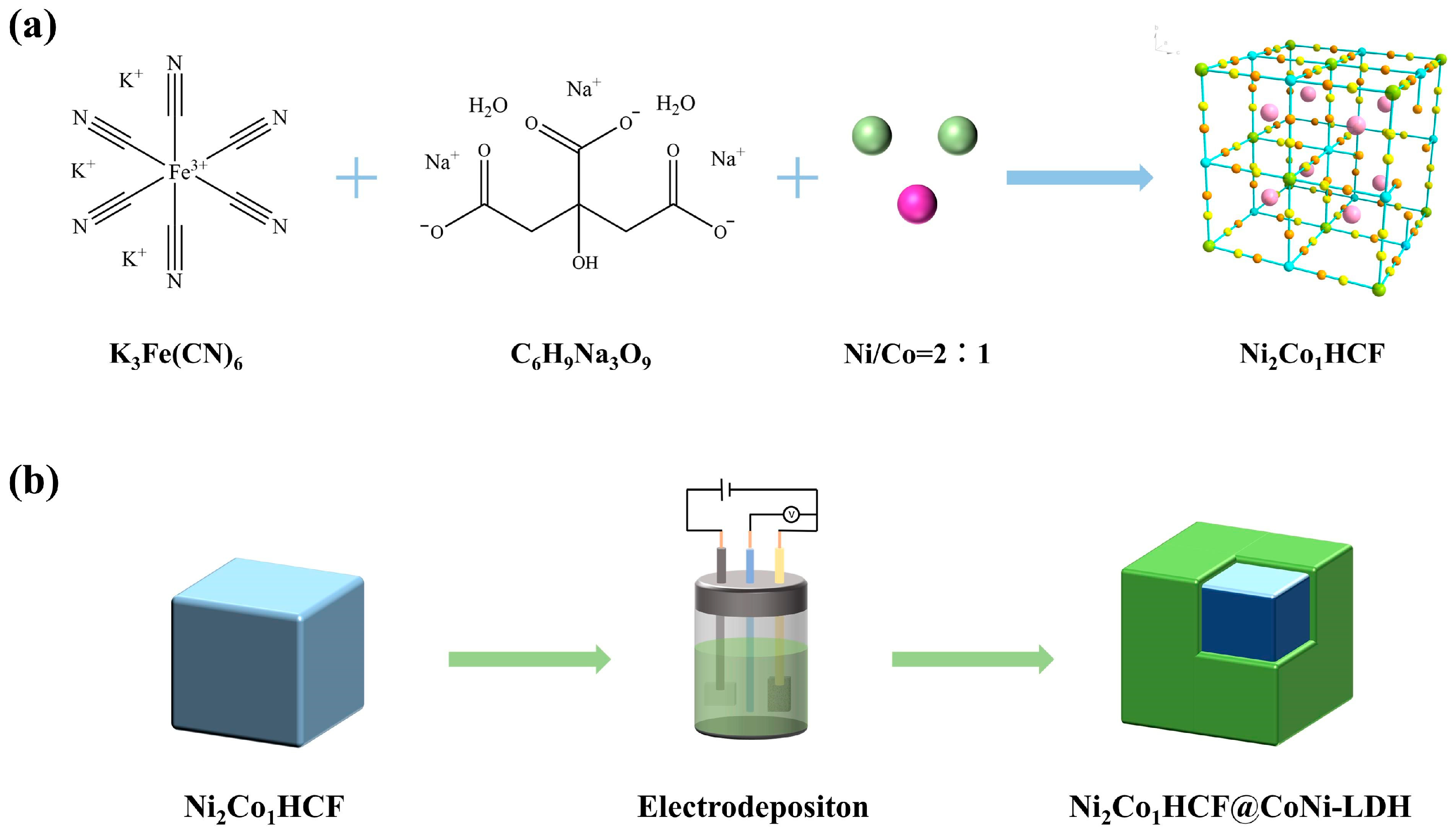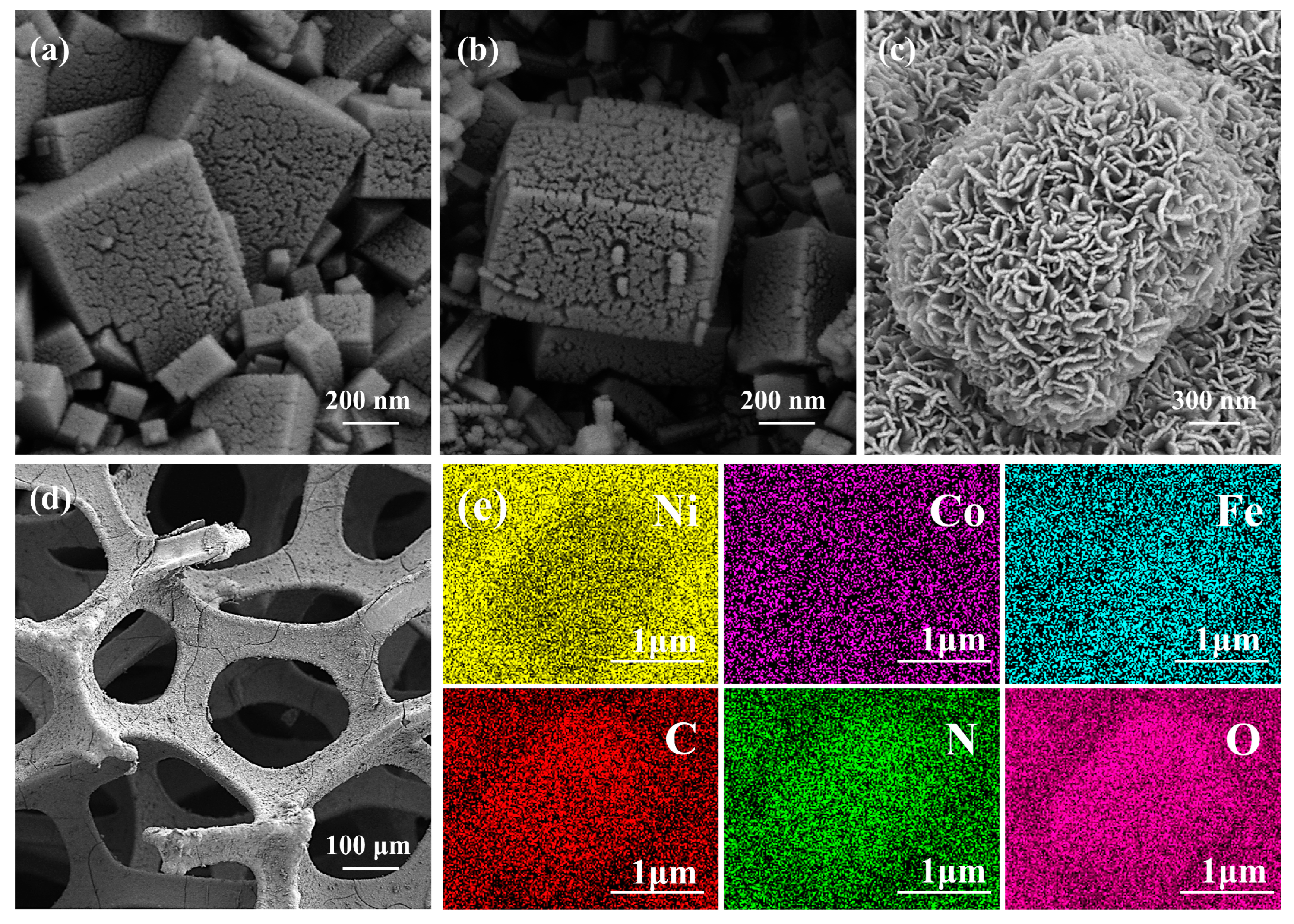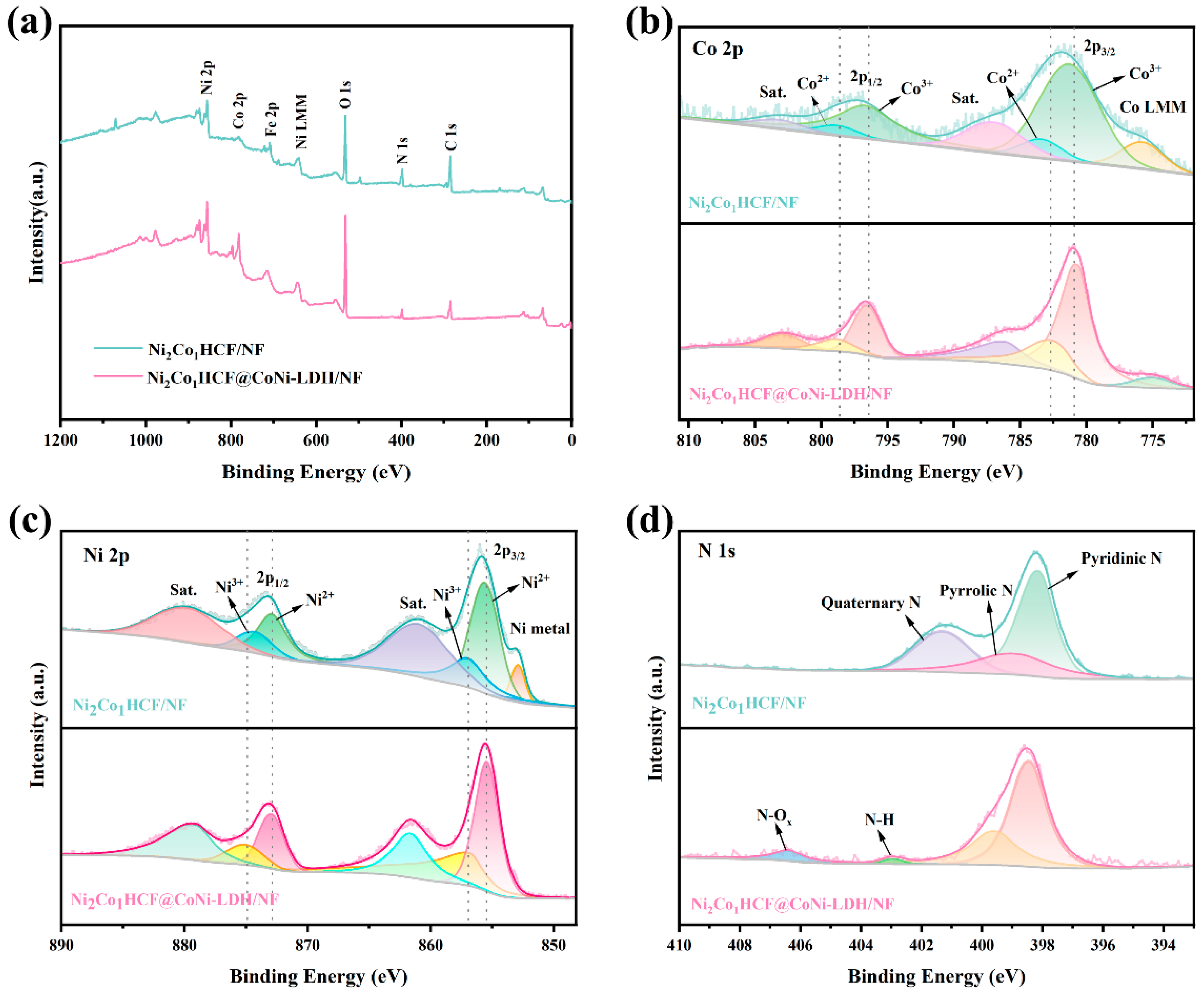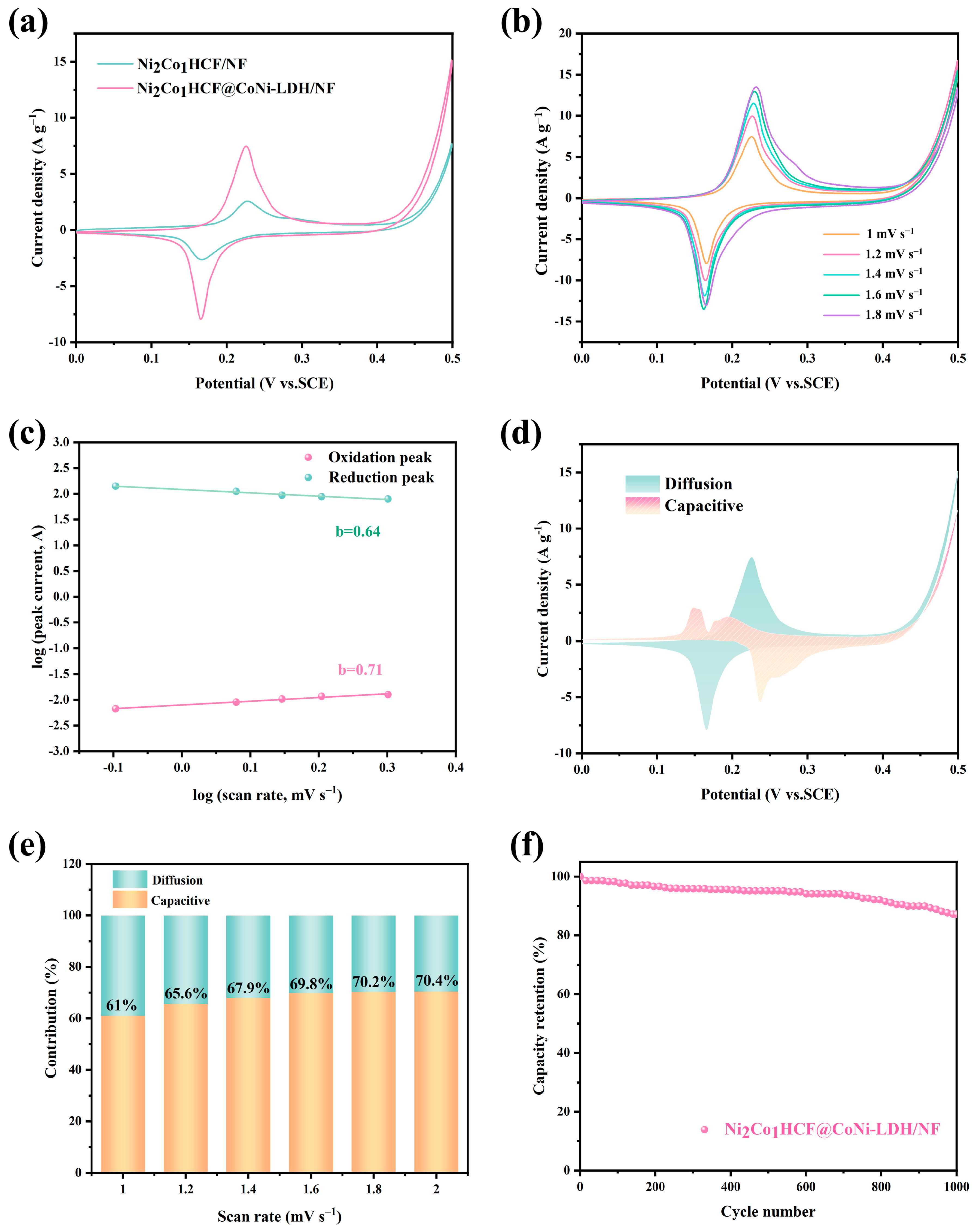NiCo Prussian-Blue-Derived Cobalt–Nickel-Layered Double Hydroxide with High Electrochemical Performance for Supercapacitor Electrodes
Abstract
:1. Introduction
2. Experimental Section
2.1. Materials
2.2. Synthesis of Ni2Co1HCF/NF
2.3. Synthesis of Ni2Co1HCF@CoNi-LDH/NF
2.4. Characterizations
2.5. Electrochemical Measurements
3. Results and Discussion
3.1. Morphology and Structure Characterization
3.2. Electrochemical Performance
4. Conclusions
Author Contributions
Funding
Institutional Review Board Statement
Informed Consent Statement
Data Availability Statement
Conflicts of Interest
References
- Fang, H.; Yang, D.; Su, Z.; Sun, X.; Ren, J.; Li, L.; Wang, K. Preparation and Application of Graphene and Derived Carbon Materials in Supercapacitors: A Review. Coatings 2022, 12, 1312. [Google Scholar] [CrossRef]
- Luo, Y.; Feng, X.; Wei, D.; Zhang, L.; Wang, Q.; Yang, F.; Qiu, S.; Xu, F.; Zou, Y.; Sun, L.; et al. Structure-Engineered Core–Shell Ni–Co–O/NiCo-LDH Nanospheres as High-Performance Supercapacitor Electrodes. Coatings 2023, 13, 353. [Google Scholar] [CrossRef]
- Liang, Y.; Wei, Z.; Wang, R.; Zhang, X. The Microwave Facile Synthesis of NiOx@graphene Nanocomposites for Application in Supercapacitors: Insights into the Formation and Storage Mechanisms. Coatings 2022, 12, 1060. [Google Scholar] [CrossRef]
- Zhou, A.J.; Cheng, W.J.; Wang, W.; Zhao, Q.; Xie, J.; Zhang, W.X.; Gao, H.C.; Xue, L.G.; Li, J.Z. Hexacyanoferrate-Type Prussian Blue Analogs: Principles and Advances Toward High-Performance Sodium and Potassium Ion Batteries. Adv. Energy Mater. 2021, 11, 2000943. [Google Scholar] [CrossRef]
- Wang, X.; Li, Q.; Yang, D.; An, X.; Qian, X. Phytic Acid Doped Polyaniline as a Binding Coating Promoting Growth of Prussian Blue on Cotton Fibers for Adsorption of Copper Ions. Coatings 2022, 12, 138. [Google Scholar] [CrossRef]
- Ruan, Y.; Chen, L.; Cui, L.; An, Q. PPy-Modified Prussian Blue Cathode Materials for Low-Cost and Cycling-Stable Aqueous Zinc-Based Hybrid Battery. Coatings 2022, 12, 779. [Google Scholar] [CrossRef]
- Shen, W.Q.; Guo, X.G.; Sun, J.; Xu, S.L.; Xu, J. Prussian blue analogues derived binary nickel-cobalt selenide for enhanced pseudocapacitance and oxygen evolution reaction. Vacuum 2019, 170, 108965. [Google Scholar] [CrossRef]
- Xiong, D.K.; Wang, S.C.; Chen, C.; Gu, M.L.; Yi, F.Y. Rational design of multiple Prussian-blue analogues/NF composites for high-performance surpercapacitors. New J. Chem. 2020, 44, 10359–10366. [Google Scholar] [CrossRef]
- Mai, L.Q.; Minhas-Khan, A.; Tian, X.C.; Mulonda Hercule, K.; Zhao, Y.L.; Lin, X.; Xu, X. Synergistic interaction between redox-active electrolyte and binder-free functionalized carbon for ultrahigh supercapacitor performance. Nat. Commun. 2013, 4, 2923. [Google Scholar] [CrossRef] [Green Version]
- Qiu, Y.; Lin, Y.; Yang, H.B.; Wang, L. Ni-doped cobalt hexacyanoferrate microcubes as battery-type electrodes for aqueous electrolyte-based electrochemical supercapacitors. J. Alloy. Compd. 2019, 806, 1315–1322. [Google Scholar] [CrossRef]
- Yi, H.C.; Qin, R.Z.; Ding, S.X.; Wang, Y.T.; Li, S.N.; Zhao, Q.H.; Pan, F. Structure and Properties of Prussian Blue Analogues in Energy Storage and Conversion Applications. Adv. Funct. Mater. 2020, 31, 2006970. [Google Scholar] [CrossRef]
- Ju, A.; Xu, R.D.; Zhang, Y.; Feng, S.Y.; Chen, C.; Liao, J. Electrodeposition of Ultrathin Nanosheets of Nickel-Cobalt Double Hydroxides with Layered Structure for Improved Supercapacitor Performance. Int. J. Electrochem. Sci. 2021, 16, 210422. [Google Scholar] [CrossRef]
- Song, F.; Zan, G.; Chen, Y.; Wu, Q.; Xu, Y. In situ transformation of iron-group ternary metal oxides nanocubes from Co/Ni-PBA for high-performance supercapacitors. J. Alloy. Compd. Interdiscip. J. Mater. Sci. Solid-State Chem. Phys. 2018, 741, 633–641. [Google Scholar] [CrossRef]
- Gao, Z.Q.; Li, Y.Y.; Zhang, C.Y.; Zhang, S.; Jia, Y.L.; Dong, Y.H. An enzyme-free immunosensor for sensitive determination of procalcitonin using NiFe PBA nanocubes@TB as the sensing matrix. Anal. Chim. Acta 2020, 1097, 169–175. [Google Scholar] [CrossRef] [PubMed]
- Wang, Y.Q.; Ma, J.Z.; Wang, J.; Chen, S.; Wang, H.S.; Zhang, J.T. Interfacial Scaffolding Preparation of Hierarchical PBA-Based Derivative Electrocatalysts for Efficient Water Splitting. Adv. Energy Mater. 2019, 9, 1802939. [Google Scholar] [CrossRef]
- Yilmaz, G.; Yam, K.M.; Zhang, C.; Fan, H.J.; Ho, G.W. In Situ Transformation of MOFs into Layered Double Hydroxide Embedded Metal Sulfides for Improved Electrocatalytic and Supercapacitive Performance. Adv. Mater. 2017, 29, 1606814. [Google Scholar] [CrossRef] [PubMed]
- Sun, J.G.; Ye, H.L.; Oh, J.A.S.; Plewa, A.; Sun, Y.; Wu, T.; Sun, Q.M.; Zeng, K.Y.; Lu, L. Elevating the Discharge Plateau of Prussian Blue Analogs Through Low-Spin Fe Redox Induced Intercalation Pseudocapacitance. Energy Storage Mater. 2021, 43, 182–189. [Google Scholar]
- Zhu, Y.L.; Du, W.; Zhang, Q.L.; Yang, H.; Zong, Q.; Wang, Q.Q.; Zhou, Z.; Zhan, J.H. A metal–organic framework template derived hierarchical Mo-doped LDHs@MOF-Se core–shell array electrode for supercapacitors. Chem. Commun. 2020, 56, 13848–13851. [Google Scholar] [CrossRef]
- Tian, Z.; Liu, Q.; Bian, B. Enhanced Catalytic Performance of CO Methanation over VOx Assisted Ni/MCF Catalyst. Sustain. Energy Fuels 2020, 4, 2396–2403. [Google Scholar] [CrossRef]
- Zhang, Y.N.; Chen, J.L.; Su, C.Y.; Chen, K.Y.; Zhang, H.B.; Yang, Y.H.; Huang, W.H. Enhanced ionic diffusion interface in hierarchical metal-organic framework@layered double hydroxide for high-performance hybrid supercapacitors. Nano Res. 2022, 15, 8983–8990. [Google Scholar]
- Liu, Q.; Ke, M.; Liu, F.; Yu, P.; Hu, H.Q.; Li, C.C. High-performance removal of methyl mercaptan by nitrogen-rich coconut shell activated carbon. RSC Adv. 2017, 7, 22892–22899. [Google Scholar] [CrossRef] [Green Version]
- Lin, Y.Q.; Zhang, L.H.; Xiong, Y.; Wei, T.; Fan, Z.J. Toward the Design of High-performance Supercapacitors by Prussian Blue, its Analogues and their Derivatives. Energy Environ. Mater. 2020, 3, 323–345. [Google Scholar] [CrossRef]
- Xiong, G.P.; He, P.G.; Wang, D.N.; Zhang, Q.Q.; Chen, T.F.; Fisher, T.S. Hierarchical Ni–Co Hydroxide Petals on Mechanically Robust Graphene Petal Foam for High-Energy Asymmetric Supercapacitors. Adv. Funct. Mater. 2016, 26, 5460–5470. [Google Scholar] [CrossRef]
- Yue, Y.F.; Zhang, Z.Y.; Binder, A.J.; Chen, J.H.; Jin, X.B.; Overbury, S.H.; Dai, S. Hierarchically Superstructured Prussian Blue Analogues: Spontaneous Assembly Synthesis and Applications as Pseudocapacitive Materials. ChemSusChem 2015, 8, 177–183. [Google Scholar] [CrossRef]
- Zhang, L.J.; Hui, K.N.; Hui, K.S.; Lee, H.W. High-performance hybrid supercapacitor with 3D hierarchical porous flower-like layered double hydroxide grown on nickel foam as binder-free electrode. J. Power Sources 2016, 318, 76–85. [Google Scholar] [CrossRef]
- Shi, Z.C.; Zhu, J.C.; Li, Z.; Xiao, Q.D.; Zhu, J.L. Sulfur-Doped Nickel–Cobalt Double Hydroxide Electrodes for High-Performance Asymmetric Supercapacitors. Acs Appl. Energy Mater. 2020, 3, 11082–11090. [Google Scholar] [CrossRef]
- Li, Q.H.; Lu, W.; Li, Z.P. Hierarchical MoS2/NiCo2S4@C urchin-like hollow microspheres for asymmetric supercapacitors. Chem. Eng. J. 2020, 380, 122544. [Google Scholar] [CrossRef]
- Ge, P.; Li, S.J.; Shuai, H.L.; Xu, W.; Tian, Y.; Yang, L.; Zou, G.Q.; Hou, H.S.; Ji, X.B. Engineering 1D chain-like architecture with conducting polymer towards ultra-fast and high-capacity energy storage by reinforced pseudo-capacitance. Nano Energy 2018, 54, 26–38. [Google Scholar] [CrossRef]
- Wang, S.C.; Xiong, D.K.; Chen, C.; Gu, M.L.; Yi, F.Y. The controlled fabrication of hierarchical CoS2@NiS2 core-shell nanocubes by utilizing prussian blue analogue for enhanced capacitive energy storage performance. J. Power Sources 2020, 450, 227712. [Google Scholar] [CrossRef]
- Zhu, X.; Tao, H.; Li, M. Co-precipitation synthesis of nickel cobalt hexacyanoferrate for binder-free high-performance supercapacitor electrodes. Int. J. Hydrogen Energy 2020, 45, 14452–14460. [Google Scholar] [CrossRef]
- Bommireddy, P.R.; Kumar, M.; Lee, Y.W.; Manne, R.; Suh, Y.; Park, S.H. Prussian blue analogue Co3(Co(CN)6)2 cuboids as an electrode material for high-performance supercapacitor. J. Power Sources 2021, 513, 230521. [Google Scholar] [CrossRef]
- Yang, W.; Ding, Q.Y.; Zhai, D.M.; Bo, K.W.; Feng, Y.Y.; Wen, J.; He, F. Fabrication and electrochemical properties of hollow cage-like nickel cobalt layered hydroxides with porous structure. Acta Phys. Sin. 2022, 71, 18201. [Google Scholar] [CrossRef]






| Samples | Rs/Ω | C/F | Rct/Ω | Zw/Ω |
|---|---|---|---|---|
| Ni2Co1HCF/NF | 0.427 | 0.045 | 0.092 | 0.112 |
| CoNi-LDH/NF | 0.374 | 0.106 | 0.4 | 0.181 |
| Ni2Co1HCF@CoNi-LDH/NF | 0.329 | 0.0934 | 0.02 | 0.152 |
| Materials | Electrolyte | Specific Capacity (F·g−1) | Capacitance Retention (Ratio) | Reference |
|---|---|---|---|---|
| Ni2CoHCF/NF | 2M KOH | 1300 (0.5 A·g−1) | 53% | [30] |
| CoHCC | 3M KOH | 1720 (1 A·g−1) | 61.2% | [31] |
| Ni4Co1-LDH | 2M KOH | 1620 (1 A·g−1) | 68% | [26] |
| Ni2Co1-LDH | 2M KOH | 963 (0.5 A·g−1) | 76.8% | [32] |
| Ni2Co1HCF@CoNi-LDH/NF | 2M KOH | 1937 (1 A·g−1) | 81.3% | This Work |
Disclaimer/Publisher’s Note: The statements, opinions and data contained in all publications are solely those of the individual author(s) and contributor(s) and not of MDPI and/or the editor(s). MDPI and/or the editor(s) disclaim responsibility for any injury to people or property resulting from any ideas, methods, instructions or products referred to in the content. |
© 2023 by the authors. Licensee MDPI, Basel, Switzerland. This article is an open access article distributed under the terms and conditions of the Creative Commons Attribution (CC BY) license (https://creativecommons.org/licenses/by/4.0/).
Share and Cite
Yin, Q.; Gao, B.; Fu, H.; Hu, L. NiCo Prussian-Blue-Derived Cobalt–Nickel-Layered Double Hydroxide with High Electrochemical Performance for Supercapacitor Electrodes. Coatings 2023, 13, 554. https://doi.org/10.3390/coatings13030554
Yin Q, Gao B, Fu H, Hu L. NiCo Prussian-Blue-Derived Cobalt–Nickel-Layered Double Hydroxide with High Electrochemical Performance for Supercapacitor Electrodes. Coatings. 2023; 13(3):554. https://doi.org/10.3390/coatings13030554
Chicago/Turabian StyleYin, Qihao, Bo Gao, Haiyang Fu, and Liang Hu. 2023. "NiCo Prussian-Blue-Derived Cobalt–Nickel-Layered Double Hydroxide with High Electrochemical Performance for Supercapacitor Electrodes" Coatings 13, no. 3: 554. https://doi.org/10.3390/coatings13030554





